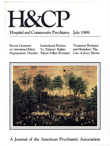Diagnosis and Treatment of Attention Deficit Disorder in Two General Hospital Clinics
Abstract
In two clinics in military general hospitals, the charts of all children with a presumptive diagnosis of attention deficit disorder who were prescribed psychostimulants (N=68) were audited to assess the quality of the primary physicians' evaluation and treatment. The audit instrument, constructed by a multidisciplinary team, indicated high interrater reliabilities, high face and concurrent validity, and moderate internal consistency. The audit found that only 51.5 percent of the children being treated with psychostimulants met the audit criteria for attention deficit disorder. A school intervention plan was documented in only 16.2 percent of the cases, and a psychotherapy intervention in only 19.1 percent; low rates were also found for other treatment and follow-up criteria. Overall , the assessment, the follow-up care, and the overall quality of care were found to be inadequate or less than adequate in about two-thirds of the cases.
Access content
To read the fulltext, please use one of the options below to sign in or purchase access.- Personal login
- Institutional Login
- Sign in via OpenAthens
- Register for access
-
Please login/register if you wish to pair your device and check access availability.
Not a subscriber?
PsychiatryOnline subscription options offer access to the DSM-5 library, books, journals, CME, and patient resources. This all-in-one virtual library provides psychiatrists and mental health professionals with key resources for diagnosis, treatment, research, and professional development.
Need more help? PsychiatryOnline Customer Service may be reached by emailing [email protected] or by calling 800-368-5777 (in the U.S.) or 703-907-7322 (outside the U.S.).



